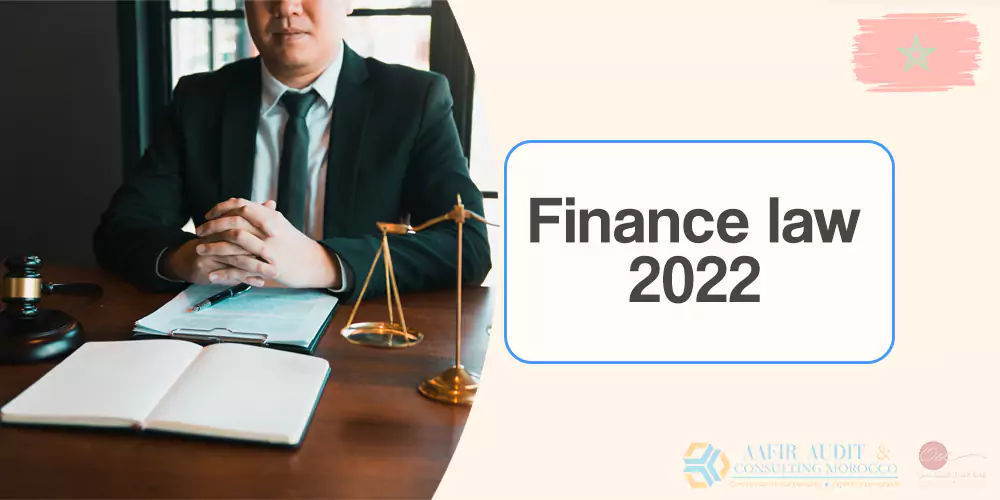Finance law 2022
The Finance Law (LF) for the 2022 budget year was published in the Official Bulletin on 20 December 2021.Here are the main tax measures to consider for fiscal years beginning on or after January 1, 2022:
Corporate tax (CIT)
- Abolition of escalation of CIT scale rates
The corporate tax is calculated on the scale proportional to the following rates:
Net tax profit (dirhams) | Rate |
Less than or equal to 300,000 | 10 |
Between 300,001 and 1,000,000 | 20 |
Greater than 1,000,000 | 31 % |
example:
- Net tax result of a company X is 3,000,000 Dirhams. The corporate tax is therefore 3,000,000 x 31% = 930,000 Dirhams.
- Net tax result of a company X is 500,000 Dirhams. The corporate tax is therefore 500,000 x 20% = 100,000 Dirhams.
The rates calculated using the proportional method shall apply for financial years beginning on or after 1 January 2022. Thus, the instalment payments due for the 2022 financial year will be calculated according to proportional rates and not progressive rates.
- Reduction of the corporate tax rate applicable to industrial activities from 28% to 26%
The finance law provides for a reduction in the marginal rate of the corporate tax scale from 28% to 26% for companies in the industrial sector whose net profit is less than 100,000,000 Dhs, and this, in respect of the profit corresponding to the local turnover.
Net tax profit (dirhams) | Rate |
Less than or equal to 300,000 | 10 |
Between 300,001 and 1,000,000 | 20 |
Between 1,000,001 and 99,999,999 | 26% |
Greater than 100,000,000 | 31 % |
Income tax (IR)
- Adaptation and improvement of the single professional contribution (CPU) regime established by the 2021 Finance Act
Natural persons whose professional income is determined according to the CPU regime are subject to income tax at the rate of 10% on the basis of the turnover achieved to which a coefficient fixed for each profession applies, adding a complementary right to medical coverage.
CPU = (CA x Coefficient) x 10% + additional charge
Coefficient by category of occupation:
Occupational categories | Coefficients | |
Trade | General food | 6 |
Other food products | 8% | |
Raw materials Building materials | 8% | |
Chemicals and fertilizers | 10 | |
Other non-food products | 12% | |
Service delivery | Light or fast food | 10 |
Restaurant operator and beverage outlet | 20 | |
Transport of people and goods | 10 | |
Maintenance activities | 15 | |
Rental of movable property | 20 | |
Other leasing and management activities | 25% | |
Hairdressing and aesthetics | 20 | |
Electronic equipment repair mechanic Arts and entertainment activities Mill operator | 30 | |
Other service craftsmen | 12% | |
Brokers | 45% | |
Other services | 20 | |
manufacturing | Food Non-food products | 10 |
Shops and specific activities | Chevillard | 4% |
Tobacconist | 3% | |
Merchant of compressed, liquefied and dissolved gas | 4,5% | |
Merchant of flour, starch, meal or bran | 5 | |
Shipowner, successful bidder or fishing farmer) | 7 | |
Baker | 8% | |
Additional rights for medical coverage:
Tranche of principal duty | Supplementary duty | |
Quarterly (DH) | Annual (DH) | |
Less than 500 | 300 | 1.200 |
From 500 to 1,000 | 390 | 1.560 |
From 1,001 to 2,500 | 570 | 2.280 |
From 2,501 to 5,000 | 720 | 2.880 |
From 5,001 to 10,000 | 1.050 | 4.200 |
From 10,001 to 25,000 | 1.500 | 6.000 |
From 25,001 to 50,000 | 2.250 | 9.000 |
> 50,000 | 3.600 | 14.400 |
- Revision of the flat-rate allowance applied to salary income paid to professional athletes, coaches, educators and technical teams.
As part of the support for the restructuring of the sports sector aimed at its transition for more professionalism and transparency and in order to allow this sector to ensure its tax compliance, particularly in terms of tax on wage income, it is proposed to revise the flat-rate allowances introduced by the 2022 Finance Act for the benefit of said income for the benefit of professional athletes, coaches, educators and technical team provided they hold a license issued by the sports federations.
As such, the 2022 Finance Act has determined the following allowances:
- 90% for the years 2021, 2022 and 2023;
- 80% for the year 2024;
- 70% for the year 2025;
- 60% for the year 2026.
Value added tax (VAT)
- Exemption from VAT without the right to deduct for recovered metals, for services carried out in the context of Takaful insurance and Takaful reinsurance operations, for transactions relating to the interest on loans extended to students in the public education of vocational training intended to finance their studies in Morocco or abroad and for companies carrying out investment projects amounting to more than 50 million Dirhams under an agreement concluded with the State.
- VAT rate applicable to sales transactions involving photovoltaic panels and solar water heaters at 10% with the right to deduct.
- Failure to adjust the VAT deduction on fixed assets for temporary disposal of immovable property carried out in the context of securitisation transactions.
Common provisions
- Maintenance of the Social Solidarity Contribution (CSS) for companies excluding companies exempt under Article 6-I-A of the CGI and natural persons subject to the Actual Net Profit Plan for the 2022 financial year
The social solidarity contribution (CSS) is calculated according to the following scale:
Amount of profit or taxable income | Subsidy rate |
From 1,000,000 DH to less than 5,000,000 DH | 1.5% |
From 5,000,000 DH to less than 10,000,000 DH | 2.5% |
From 10,000,000 DH to less than 40,000,000 DH | 3.5% |
Greater than or equal to 40,000,000 DH | 5 |
It should be remembered that CSS is not deductible from the tax result. The payment of CSS must be before March 31, 2022 for companies and June 1, 2021 for natural persons.
- Reduction of the minimum contribution rate from 0.50% to 0.40% for companies whose current profit excluding depreciation is profitable.
The minimum contribution rate applicable to corporate and income tax, from 0.50% to 0.40% for companies whose current result excluding depreciation is declared positive.
- Introduction of an incentive regime applicable to transactions involving the transfer of assets and liabilities of microfinance associations to a public limited company.
- Exemption of transactions involving the transfer of immovable property from former local authorities to newly created ones.
- Introduction of a 70% allowance during the year 2022 applicable to the net capital gain realized on the sale of fixed assets excluding land and buildings under certain conditions.
- Cancellation of penalties, surcharges and recovery costs on tourist transport operations assessed during the period from January 1, 2020 to December 31, 2021.
Strengthening of taxpayer guarantees in the event of tax audits
- Improvement of the mechanism for oral and adversarial debate
Before the closure of the accounting audit, the taxpayer is invited to an oral and adversarial exchange concerning the corrections envisaged before the notification of the adjustments.
For this purpose, the taxpayer shall be informed of the date fixed for this exchange and the date on which the audit would be closed.
- Management accountability for notification of adjustments
In order to improve the quality of notifications of adjustments, in particular by making the auditor’s hierarchy accountable, it has been introduced to replace the term “inspector” by “administration” in the articles of the CGI relating to the accounting audit procedure.
- Establishment of Regional Tax Appeal Commissions (CRRF)
The establishment of a new commission called “Regional Tax Appeal Commission” (CRRF) to which the following appeals will be addressed:
- Those relating to the audit of the accounts of taxpayers whose declared turnover is less than ten (10) million dirhams;
- Those relating to adjustments in respect of income and profits from movable capital.
Taxpayer representatives may be chosen from among public accountants or chartered accountants. The first taxpayers’ representatives may be called upon to sit immediately after their appointment.
- Reorganisation of local taxation powers (CLT)
Share the competences of the local taxation commission currently provided for by Article 225 of the CGI with the new CRRF commission.
Consequently, the powers of the existing local tax commissions (“CLTs”) will be limited to corrections regarding:
- Professional income determined according to the system of the single professional contribution;
- Land income and profits;
- Registration and stamp duties.
- Reorganization of the composition of the National Tax Appeals Commission (CNRF)
With the aim of enhancing the effectiveness of the CNRF, the following measures have been adopted:
- Specify that taxpayer representatives may be chosen from among public accountants and/or chartered accountants;
- Set at three (3) years, renewable only once, the period during which the members representing the administration sit on the Commission;
- automatically extend the mandate of the representatives of outgoing taxpayers until the appointment of the new representatives;
- Expand the cases of incompatibility to cover all members of the commission who have already had to deal with the dispute.
Cabinet AAFIR remains at your disposal for all your comments below.






